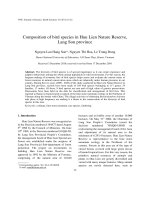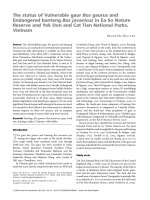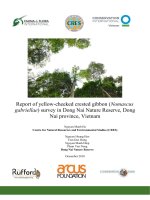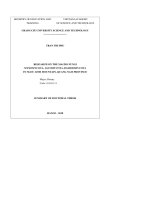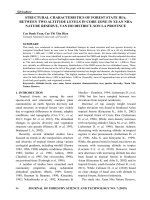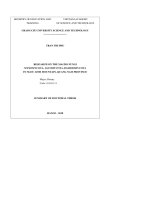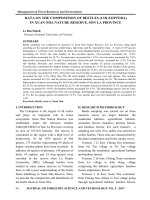Application of automatic recorder and sound analysis in surveying the presence and distribution of bird species in Ngoc Linh nature reserve, Quang Nam province
Bạn đang xem bản rút gọn của tài liệu. Xem và tải ngay bản đầy đủ của tài liệu tại đây (416.48 KB, 7 trang )
Management of Forest Resources and Environment
APPLICATION OF AUTOMATIC RECORDER AND SOUND ANALYSIS
IN SURVEYING THE PRESENCE AND DISTRIBUTION OF BIRD SPECIES
IN NGOC LINH NATURE RESERVE, QUANG NAM PROVINCE
Vu Tien Thinh1, Le Thi Dinh2, Tran Van Dung3, Nguyen Thi Hoa4, Nguyen Chi Thanh5,
Dong Thanh Hai6, Nguyen Dac Manh7, Giang Trong Toan8, Nguyen Huu Van9, Thao A Tung10
1,3,4,6,7,8,9,10
Vietnam National University of Forestry
The Law and Policy of Sustainable Development Research Center
5
Bac Giang Agriculture and Forestry University
2
SUMMARY
It is necessary to have accurate information on a species' presence and distribution in order to monitor and
protect an endangered species. While traditional survey methods have a several limitations, using automatic
recorders in monitoring wildlife provides significant promise for detecting bird species. In this study we
examined the application of automatic recorders and the associated sound analysis software (RAVEN software)
to survey for the presence of 21 bird species. The survey was conducted at 11 study sites in three communes in
Ngoc Linh Nature Reserve, Quang Nam province in June and July of 2016. The recordings and subsequent
analysis detected the sounds of 9 bird species out of the total of 21 targeted bird species. The different species
identified were detected with varying levels of frequency. While some species were detected many times in a
recording and in various recordings, the others only appeared a few times in all recordings. Their active time
during sampling period (3.00 - 9.00 AM) varied by species.
Keywords: Automatic recorders, biodiversity monitoring, bird monitoring, Ngoc Linh, RAVEN.
I. INTRODUCTION
The management of endangered bird
species requires detailed data on the presence
and distribution of the species which is often
hard to obtain. Traditional methods of
surveying bird species may have a range of
limitations and often do not give accurate
information. Some birds are active very early
in the morning, therefore, human surveyors
will experience difficulty accessing field sites
before or at dawn. Additionally, traditional
methods require specialist surveyors who are
usually not present in protected areas. One
newly developed method is to use automatic
sound recorders to gather information on the
species for long periods of time with minimal
human involvement. Autonomous recorders
and software for data processing are now
available and can provide a highly efficient
method for biodiversity monitoring.
Ngoc Linh Nature Reserve (NLNR) is
located in Nam Tra My district, Quang Nam
province. The nature reserve is a part of a site
that is considered an important Bird Area
(Tordoff et al, 2002). So far, 194 bird species
belonging to 33 families of 11 orders have
been recorded in the nature reserve. NLNR is
also home for many endangered birds species,
including 10 species listed in Red Book of
Vietnam, 8 species in IUCN threatened species
list, and 09 species in Decree 32. Most
importantly, the nature reserve supports one
endemic bird species, the Golden-winged
Laughingthrush (Garrulax ngoclinhensis),
which is known to be restricted to the Central
Annamites. Although, several studies on the
avian community have been conducted
(Tordoff et al, 2002; Tordoff et al, 2000; Le
Trong Trai, 1999), most of the surveys were
conducted more than a decade ago.
Ngoc Linh Nature Reserve is facing many
difficulties in monitoring its diversity. It covers
a large area and spans several high mountains.
An experiment using automatic recorders for
monitoring bird species in NLNR will be
useful for management purposes. This is the
first time that automated recorders were used
for assessing biodiversity in Vietnam
JOURNAL OF FORESTRY SCIENCE AND TECHNOLOGY NO. 5 - 2017
101
Management of Forest Resources and Environment
II. RESEARCH METHODOLOGY
Field survey: A field survey was conducted
in NLNR in June and July 2016. Each
sampling site was sampled for at least 1 - 2
days. At each site two full spectrum recorders
synchronized with satellite clock (SM3,
Wildlife Acoustics Inc.) were set up 500 - 1
km apart (Fig. 1). The recorders were attached
to trees. The recorders were set to record from
03.00 to 9.00 on both channels with a gain of
+48 dB and sampling rate of 2400 Hz.
Recordings were saved to disk in a compressed
(native.wac) format at one hour intervals.
Batteries and memory disks were changed
when the recorders were moved to other sites.
Figure 1. Survey design
Data analysis: Analyses found variation in
birdsong signals, including frequency range,
the speed of pitch modulation, vocabulary size,
and song duration. Each song of a bird species
has a different spectrogram that is a visual
representation of the spectrum of frequencies
in a sound. Spectrograms can be used to detect
the calls of selected bird species.
Recording data was analyzed in RAVEN
software (Cornell Lab of Ornithology) to
detect the spectrogram of bird species.
Figure 2. Map of study sites in Ngoc Linh Nature Reserve
102
JOURNAL OF FORESTRY SCIENCE AND TECHNOLOGY NO. 5 - 2017
Management of Forest Resources and Environment
We focused on 21 bird species including:
throated
fulvetta
(Alcippe
rufogularis),
Oriental Bay Owl (Phodilus badius), Mountain
Mountain Fulvetta (Alcippe peracensis), Buff-
Scops Owl (Otus spilocephalus), Indian Scops-
breasted Babbler (Trichastoma tickelli), Stripe-
owl (Otus bakkamoena), Brown Wood Owl
throated Yuhina (Yuhina gularis), Crested
(Strix
leptogrammica),
Collared
owlet
(Glaucidium brodiei), Great Eared-nightjar
(Eurostopodus
macrotis),
Large
Scimitar
Argus (Rheinardia ocellata), Rufous-throated
Partridge
(Arborophila
rufogularis),
Bar-
backed partridge (Arborophila brunneopectus)
Babbler (Pomatorhinus hypoleucos), Golden
and
babbler (Stachyris chrysaea), Grey-throated
erythrocephalus). Available sample songs of
babbler (Stachyris nigriceps), Pin-striped tit-
these species were adopted from Scharringa
babbler (Macronous gularis), Golden-breasted
(2005). If sampling frequency of the recording
chrysotis),
Red-headed
trogon
(Harpactes
Grey-hooded
and the sample file were not the same, we used
fulvetta (Alcippe cinereiceps), Grey-hooded
Audacity software (The Audacity Team) to
fulvetta (Alcippe cinereiceps), Rufous-winged
convert the frequency of the recordings into
fulvetta
fulvetta
(Alcippe
(Alcippe
castaneceps),
Rufous-
the same sampling frequency.
Figure 3. Spectrogram correlation process
We used the "correlator" tool in RAVEN to
30-minute interval recordings in study sites
find the most similar spectrogram; regions with
from 3 AM to 9 AM because most of targeted
a correlator index higher than 40 % were then
birds are active at that time.
checked carefully and visually (Fig. 3).
III. RESULTS AND DISCUSSION
Suitable minimum and maximum frequency
Presence of targeted bird species
were applied for each species. We chose the
Of 21 bird species examined, 9 species were
JOURNAL OF FORESTRY SCIENCE AND TECHNOLOGY NO. 5 - 2017
103
Management of Forest Resources and Environment
indentified to be present in the study area.
families (Table 1).
These 9 bird species belong to 4 orders and 5
Table 1. List of detected bird species in Ngoc Linh Nature Reserve
No.
Species name
Scientific name
Family
Order
Site
1
Crested Argus
Rheinardia ocellata
Phasianidae
Galliformes
2
Mountain Scops Owl
Otus spilocephalus
Strigidae
Strigiformes
3
Collared owlet
Glaucidium brodiei
Strigidae
Strigiformes
Tra Tap
4
Red-headed trogon
Trogonidae
Trogoniformes
Tra Tap
5
Mountain Fulvetta
Alcippe peracensis
Pellorneidae
Passeriformes
Tra Tap
Trichastoma tickelli
Pellorneidae
Passeriformes
Tra Tap
Stachyris chrysaea
Timaliidae
Passeriformes
Alcippe chrysotis
Timaliidae
Passeriformes
Tra Tap
Timaliidae
Passeriformes
Tra Linh
6
7
8
9
Buff-breasted
Babbler
Golden babbler
Golden-breasted
fullvetta
Harpactes
erythrocephalus
Pin-striped tit-babbler Macronous gularis
Tra Tap, Tra Leng
Tra Tap, Tra
Leng, Tra Linh
Tra Tap, Tra Linh,
Tra Leng
One of the possible reasons for high
Argus and Collared owlet is close to 1KHz
frequency of detection of 9 species could be
(Table 2). Sounds of other species such as
that these bird species have loud vocalizations
Mountain fulvetta, Buff-breasted, Babbler
which can be heard from a long distance, such
Golden-breasted fulvetta, and Pin-striped tit-
as Crested Argus, Mountain Scops Owl,
babbler
Collared
in
approaching 6KHz or higher. This explains
particular, the sounds of the of Mountain Scops
why the sounds of bird species that emit low-
Owl, Collared owlet, Red-headed trogon,
frequency sound can be heard at very long
Crested argus, and Golden babbler are in low
distance and the chance to detect those species
frequency range, usually smaller than 2.5 KHz.
is higher.
owlet,
Red-headed
trogon.
has
much
higher
frequency,
Especially, the frequency of sounds of Crested
104
JOURNAL OF FORESTRY SCIENCE AND TECHNOLOGY NO. 5 - 2017
Management of Forest Resources and Environment
Table 2. The comparison between the sonogram of detected birds
and the sample sonogram of targeted birds
The sonogram in
The sonogram
The sample
Species
The sample
the recording
in the recording
sonogram
name
sonogram
Buffbreasted
Babbler
Species
name
Crested
Argus
Mountain
Scops
Owl
Golden
babbler
Collared
owlet
Goldenbreasted
fullvetta
Redheaded
trogon
Striped
TitBabbler
Mountain
Fulvetta
We found that some bird species usually
sang or called at dawn such as Mountain Scops
Owl, Collared owlet, Crested Argus.
Meanwhile, others including Golden babbler
and Crested Argus often started vocalizing at
later time of the day (Table 3).
Table 3. The active time during the day of each species
No.
Species name
Singing peak during the day
1
Crested Argus
5:00 – 9:00 AM
2
Mountain Scops Owl
3:00 – 7:30 AM
3
Collared owlet
4:30 – 7:00 AM
4
Red-headed trogon
5:30 – 7:30 AM
5
Mountain Fulvetta
6:00 – 6:30 AM
6
Buff-breasted
breasted Babbler
6:30 – 7:30 AM
7
Golden babbler
5:00 – 8:30 AM
8
Golden-breasted
breasted fullvetta
6:00 – 6:30 AM
9
Pin-striped tit-babbler
babbler
6:30 – 7:00 AM
Using automatic recorders can be
considered an effective survey method for a
wide range of reasons. The primary reason is
that it is suitable for surveying bird species that
do not vocalize regularly. Another reason is
that surveying with automatic recorders
recorde causes
less human disturbance than traditional
surveys. In addition, they can be beneficial
when surveys are carried out in the areas which
are difficult to access. The tasks of field
surveyors are only deploying them to other
places or replacing the ba
batteries. Besides,
monitoring program does not need specialist
surveyors for the field survey. People with
JOURNAL OF FORESTRY SCIENCE AND TECHNOLOGY NO. 5 - 2017
105
Management of Forest Resources and Environment
basic skills in operating the recorder can
participate in the field data collection. Data
could be analyzed more easily if the sound
sample is available.
The distribution of detected bird species
The number of bird species in Tra Tap
commune made up the largest percentage (8
species) in total number of detected bird
species in Ngoc Linh Nature Reserve (Figure
4). Meanwhile, those in Tra Linh and Tra Leng
communes contributed a small proportion with
three species detected in each commune. This
can be explained by the fact that the numbers
of recorders used varied by commune.
Figure 4. Spatial distribution map of detected birds
in Ngoc Linh Nature Reserve
IV. CONCLUSION
Of 21 bird species targeted by the study, we
detected the sounds of 9 species including
Mountain Scops Owl, Collared owlet, Crested
Argus, Red-headed trogon, Golden babbler,
Mountain Fulvetta, Buff-breasted Babbler,
Golden-breasted fulvetta and Striped TitBabbler.
The frequency of detection varied among
species. Some birds were detected many times
in the recordings, such as Mountain Scops
Owl, Collared owlet, Crested Argus, Redheaded trogon and Golden babbler. The sounds
of other species were detected a few times in
all recordings.
The active time during surveying period
(3.00-9.00 AM) of detected bird species varies
106
by species. Some species including Mountain
Scops Owl, Collared Owlet, Crested Argus
usually called or sang in the very early
morning while other species start calling in
later time.
The number of bird species in Tra Tap
commune made up the largest percentage (8
species) in total number of detected bird
species, the number of bird species detected in
Tra Linh and Tra Leng commune contributed a
small proportion.
Acknowledgement
We would like to thank Vietnam National
Foundation for Science and Technology
(NAFOSTED) for support given to this
project. Our gratitude is also extended to forest
rangers and local people in Ngoc Linh nature
JOURNAL OF FORESTRY SCIENCE AND TECHNOLOGY NO. 5 - 2017
Management of Forest Resources and Environment
reserve for permitting us to conduct the survey
in NLNR.
REFERENCES
1. Acedevo et al. (2009). “Automated classification
of bird and amphibian calls using machine learning: a
comparison of methods”. Ecological Informatics.
2. Andrew et al. (2013). “A practical comparison of
manual and autonomous methods for acoustic
monitoring”.
3. Bardeli (2010). “Detecting bird sounds in a
complex acoustic environment and application to
bioacoustics monitoring”. Pattern Recognition Letters.
4. Brandes (2008). “Automated sound recording
and analysis techniques for bird surveys and
conservation”. Bird Conservation International.
5. Keith. “Acoustic surveys of birds using electronic
recordings: new potential from an omnidirectional
microphone system”.
6. Mieke C. Zwart et al. (2014). "The Use of
Automated Bioacoustic Recorders to Replace HumanWildlife Surveys: An Example Using Nightjars".
7. Tordoff, A. W., Tran Hieu Minh and Tran Quang
Ngoc (2000). “A feasibility study for the establishment
of Ngoc Linh Nature Reserve, Quang Nam province,
Vietnam”. Hanoi: BirdLife International Vietnam
Programme and the Forest Inventory and Planning
Institute. In Vietnamese.
8. Tordoff, A. W. ed. (2002). “Directory of
important bird areas in Vietnam: key sites for
conservation”. Hanoi: BirdLife International in
Indochina and the Institute of Ecology and Biological
Resources.
SỬ DỤNG MÁY GHI ÂM TỰ ĐỘNG VÀ KỸ THUẬT PHÂN TÍCH ÂM THANH
TRONG ĐIỀU TRA SỰ CÓ MẶT VÀ PHÂN BỐ CỦA MỘT SỐ LOÀI CHIM
TẠI KHU BẢO TỒN THIÊN NHIÊN NGỌC LINH, TỈNH QUẢNG NAM
Vũ Tiến Thịnh1, Lê Thị Định2, Trần Văn Dũng3, Nguyễn Thị Hòa4, Nguyễn Chí Thành5,
Đồng Thanh Hải6, Nguyễn Đắc Mạnh7, Giang Trọng Toàn8, Nguyễn Hữu Văn9, Thào A Tung10
1,3,4,6,7,8,9,10
Trường Đại học Lâm nghiệp
Trung tâm nghiên cứu Pháp luật và Chính sách phát triển bền vững
5
Trường Đại học Nông Lâm Bắc Giang
2
TÓM TẮT
Để phục vụ cho công tác quản lý và bảo vệ các loài động vật hoang dã, các thông tin về sự có mặt và phân bố
của chúng là hết sức cần thiết. Trong khi các phương pháp truyền thống có những hạn chế nhất định, việc sử
dụng máy ghi âm tự động và kỹ thuật phân tích âm thanh mang đến những điểm mạnh trong việc phát hiện các
loài chim hoang dã. Trong nghiên cứu này, chúng tôi sử dụng máy ghi âm tự động và phần mềm RAVEN để
điều tra 21 loài chim thuộc 3 xã tại Khu Bảo tồn thiên nhiên Ngọc Linh, tỉnh Quảng Nam trong khoảng thời
gian từ tháng 6 đến tháng 7 năm 2016. Sau khi phân tích dữ liệu, có 9 loài chim đã được phát hiện. Tuy nhiên,
tần số xuất hiện của chúng rất khác nhau. Trong khi một số loài chim xuất hiện rất nhiều lần trong một bản ghi
âm và nhiều bản ghi âm khác nhau, một số loài khác chỉ xuất hiện rất ít lần trong tất cả các bản ghi âm. Thời
gian mà các tiếng kêu được ghi nhận trong khoảng thời gian chúng tôi đặt máy (3:00 - 9:00) cũng rất khác nhau
giữa các loài.
Từ khóa: Giám sát chim, giám sát đa dạng sinh học, máy ghi âm tự động, Ngọc Linh, RAVEN.
Received
Revised
Accepted
: 15/3/2017
: 03/7/2017
: 12/7/2017
JOURNAL OF FORESTRY SCIENCE AND TECHNOLOGY NO. 5 - 2017
107
